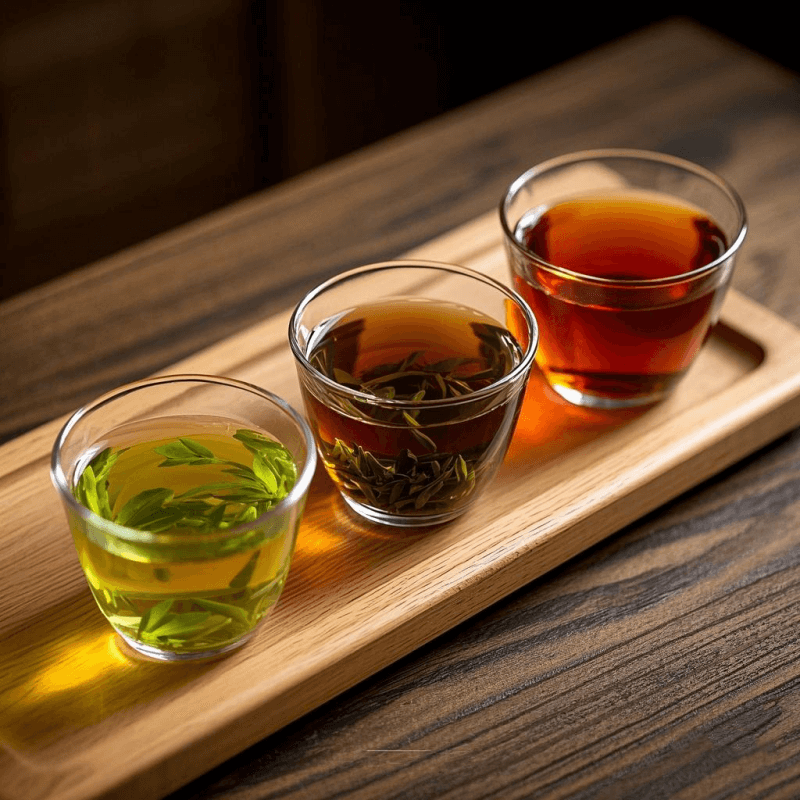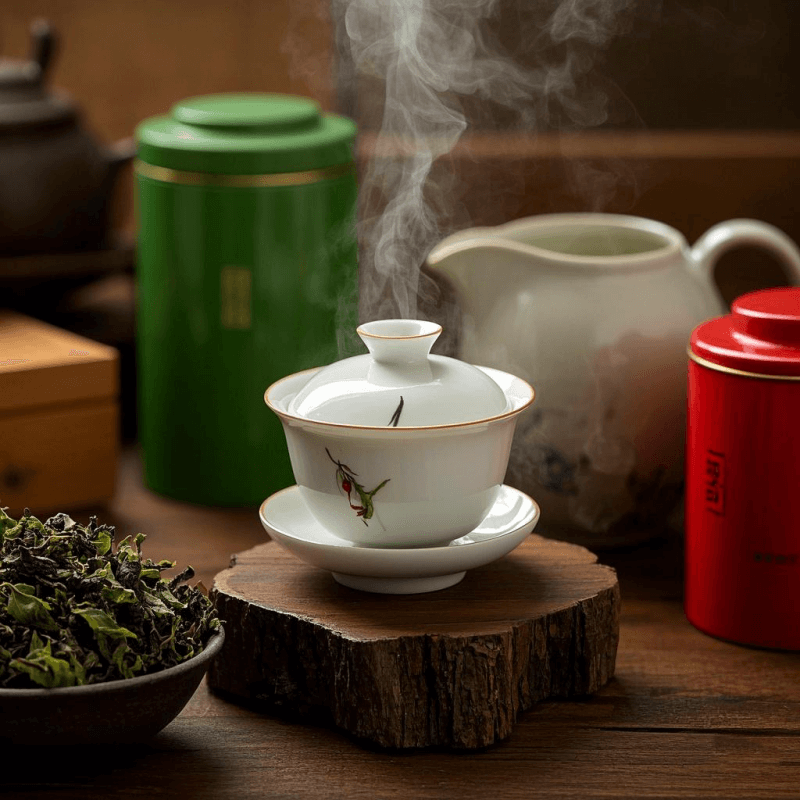1. Introduction: Why Everyone’s Asking “Is Oolong Tea Black or Green Tea?”
Is Oolong Tea Black or Green Tea???

Walk into any tea shop, and you’ll likely see shelves labeled “green,” “black,” and “oolong”—but confusion lingers. A 2024 survey by the Tea Association of America found that 58% of casual tea drinkers can’t distinguish oolong from green or black tea, often asking, “Is oolong tea black or green tea?” This mix-up isn’t trivial: misclassifying oolong can lead to poor brewing choices (like using boiling water for a delicate oolong, which ruins its flavor) or missing out on its unique benefits.
Understanding where oolong stands matters because it’s neither black nor green, but a category of its own—one that bridges the two with complexity and versatility. This guide breaks down the science, processing, and culture behind the question, so you can appreciate oolong for what it truly is.
2. The Basics: Defining Black, Green, and Oolong Tea
Is Oolong Tea Black or Green Tea:
To answer “Is oolong tea black or green tea,” we first need clear definitions. All three come from the Camellia sinensis plant, but their paths diverge during processing:
🌱 Green Tea
- Processing: Leaves are harvested, withered briefly, then immediately “fixed” (steamed or pan-fried) to stop oxidation. This locks in their bright green color and fresh, grassy flavor.
- Oxidation Level: 0–5% (minimal to none).
- Examples: Japanese sencha, Chinese longjing (Dragon Well).
⚫ Black Tea
- Processing: Leaves are withered, rolled to break cell walls, then fully oxidized (exposed to oxygen) until they turn dark brown/black. Finally, they’re dried to preserve the rich, robust flavor.
- Oxidation Level: 80–100% (full oxidation).
- Examples: Assam, Darjeeling, English Breakfast.
🍵 Oolong Tea
- Processing: A middle ground. Leaves are withered, rolled to trigger partial oxidation, then fixed at a specific stage to halt the process. This creates a spectrum of flavors, from floral to roasted.
- Oxidation Level: 10–80% (varies by style).
- Examples: Tie Guan Yin (light oolong), Da Hong Pao (dark oolong), Taiwanese Alishan.
The key takeaway? Oxidation—the chemical reaction between leaf enzymes and oxygen—defines each category. Green tea avoids it, black tea embraces it fully, and oolong tea dances in between.
3. The Oxidation Process: Why Oolong Sits Between Black and Green Tea
Oxidation is the magic (and science) that separates tea types. Let’s break down how it works, and why it answers “Is oolong tea black or green tea”:
🔬 How Oxidation Transforms Tea
When Camellia sinensis leaves are damaged (via rolling or bruising), enzymes called polyphenol oxidases react with oxygen in the air. This breaks down catechins (antioxidant compounds) into new molecules:
- Green Tea: Fixed immediately, so catechins (like EGCG) remain intact, giving it a sharp, vegetal taste.
- Black Tea: Oxidized fully, catechins convert to theaflavins (bittersweet) and thearubigins (malty), creating bold, rich flavors.
- Oolong Tea: Oxidized partially, so it retains some catechins while developing theaflavins. This mix creates complexity—neither as sharp as green nor as robust as black.
🌡️ Controlling Oxidation in Oolong
Master tea makers treat oxidation like a fine art. For light oolongs (e.g., Tie Guan Yin), oxidation stops at 10–30%, preserving floral, fruity notes. For dark oolongs (e.g., Da Hong Pao), it continues to 60–80%, developing roasted, nutty profiles. This range is why oolong tea can taste closer to green in one form and black in another—but it’s never truly either.
As Tea Research Institute explains, “Oolong’s oxidation sweet spot is what makes it a category of its own, not a subset of green or black tea.”
4. Brewing Differences: How Oolong, Black, and Green Tea Are Handled
Brewing methods highlight why “Is oolong tea black or green tea” matters—each requires distinct care to shine:
🌱 Green Tea Brewing
- Water Temperature: 160–180°F (70–82°C). Boiling water burns catechins, creating bitterness.
- Steep Time: 1–2 minutes. Over-steeping amplifies astringency.
- Tools: Glass or porcelain teapots (to avoid absorbing delicate flavors).
⚫ Black Tea Brewing
- Water Temperature: 200–212°F (93–100°C). Higher heat extracts full-bodied flavors.
- Steep Time: 3–5 minutes. Longer steeps bring out malty depth.
- Tools: Ceramic or metal teapots (retain heat well).
🍵 Oolong Tea Brewing
- Water Temperature: 185–205°F (85–96°C). Adjust based on oxidation—lower for light oolongs, higher for dark.
- Steep Time: 30 seconds to 5 minutes (multiple infusions). Gongfu-style brewing (short, repeated steeps) reveals layers of flavor.
- Tools: Gaiwan (lidded cup) or Yixing clay teapot (absorbs subtle oils to enhance future brews).
Mistaking oolong for green or black tea during brewing ruins its nuances. A light oolong steeped like black tea (boiling water, 5 minutes) becomes bitter, while a dark oolong treated like green tea (cool water, 1 minute) tastes flat.
5. Flavor and Appearance: Oolong’s Unique Identity
🌈 Appearance
- Green Tea: Dry leaves are bright green; brewed liquor is pale yellow-green.
- Black Tea: Dry leaves are dark brown/black; brewed liquor is deep amber/red-brown.
- Oolong Tea: Dry leaves range from olive green (light) to dark brown (dark); brewed liquor spans golden-amber (light) to reddish-brown (dark).
👃 Flavor Profiles
- Green Tea: Grass, seaweed, fresh spinach, or mild sweetness (e.g., Japanese matcha’s “umami”).
- Black Tea: Malt, caramel, dark fruit (e.g., Darjeeling’s “muscatel”), or cocoa.
- Oolong Tea:
- Light: Jasmine, peach, honey, or buttery (e.g., Taiwanese Alishan).
- Dark: Roasted chestnut, caramel, or mineral (e.g., Wuyi Da Hong Pao).
These differences are stark. Even the darkest oolong lacks black tea’s heavy maltiness, and the lightest oolong avoids green tea’s sharp vegetal notes.
6. Health Benefits: How Oolong Compares to Black and Green Tea
While all teas offer perks, their unique compounds mean different benefits—another reason “Is oolong tea black or green tea” matters:
🌱 Green Tea Benefits
- High in EGCG: A potent antioxidant linked to boosted metabolism and heart health (per Healthline).
- Lower Caffeine: 20–30mg/cup, making it gentle for sensitive stomachs.
⚫ Black Tea Benefits
- Rich in Theaflavins: May support cholesterol levels and gut microbiome diversity (study in Journal of Nutrition).
- Higher Caffeine: 40–70mg/cup, ideal for a morning energy boost.
🍵 Oolong Tea Benefits

- Balanced Antioxidants: Combines green tea’s catechins and black tea’s theaflavins, supporting both metabolism and heart health.
- Moderate Caffeine: 30–50mg/cup, offering focus without jitters—perfect for afternoons.
- Unique Polyphenols: A 2020 study in Nutrients found oolong’s mix of compounds may improve insulin sensitivity better than green or black tea alone.
7. Conclusion: Oolong Tea Is Neither Black nor Green—It’s in a League of Its Own
The answer to “Is oolong tea black or green tea” is clear: neither. Oolong tea is a distinct category defined by partial oxidation, a spectrum of flavors, and a brewing tradition that celebrates its versatility. It shares the Camellia sinensis plant with black and green tea, but its intentional processing creates something entirely unique—bridging freshness and depth in a way no other tea can.
Whether you prefer light, floral oolongs that dance close to green tea or dark, roasted varieties that echo black tea’s richness, oolong tea invites exploration. Discover the authentic taste of oolong tea in our premium selection to experience its range for yourself.
In the end, the beauty of tea lies in its diversity. Green tea excels in crispness, black in boldness, and oolong? It’s the perfect balance—a reminder that some of life’s best things exist in the middle.
Wondering is oolong tea black or green tea? Explore how oolong tea differs from both, from oxidation to flavor. Clear answers to help you choose—click to learn more!
